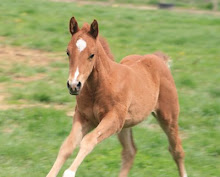| Written by Mark Thompson |
| Phil Rapp, with Playboys Ruby Too (at left) and Whats On Tap, the 3-year-old clones of standout cutting mares Playboys Ruby and Tap O Lena. The trainer of the last clone entered in the 2009 National Cutting Horse Association Futurity said on Nov. 9 that it’s unlikely the mare will compete at the Nov. 21-Dec. 13 event. “Most likely, that mare will not show at the Futurity,” said Phil Rapp, Weatherford, Texas, cutting’s all-time leading money earner as a rider and one of the industry’s leading owners and breeders. Rapp was referring to Playboys Ruby Too, a clone of Playboys Ruby. “She’s got some lameness issues that we’re dealing with and it’s most likely that she will not compete,” Rapp explained. Asked if she might compete as a cutter next year, Rapp said, “That is to be determined, by the severity of the lameness and how she responds to the medication, the time off and how she comes back.” Of course, there are other clones in training and there are also other opinions. A Doc’s Serendipity clone (Doc Bar x Biltoft’s Poco x Bar Mix) had been entered in the 2009 NCHA Futurity, too, but she was pulled because of a problem with her sight. Based on his experience with this clone, David Brown, Gainesville, Texas, said it is possible for a clone to compete well. Brown owned Doc’s Serendipity when the late 1974 mare finished as 1977 NCHA Futurity Open Reserve Champion. Brown purchased his Doc’s Serendipity clone as a yearling at the 2007 NCHA Futurity Sale for $14,000. He described her as “a super horse and very talented.” Brown initiated the clone’s training and had Texas trainer Jaime Beamer work with her on cows as a 3-year-old, but then decided the mare would not be able to overcome an ocular problem. “She’s got a spot on her eye about the size of your index fingernail,” Brown said. “She kept losing cows on that side and I stopped [training her]. I think she could have been a [NCHA Futurity] finalist horse without that, but I’d just hate to get her beat. There’s no sense putting her in a position that she can’t help.” The Doc’s Serendipity clone has already produced a High Brow Cat foal. She’ll produce another one, by Metallic Cat, next year, Brown said. While optimistic she’ll perform well as a breeder, Brown said if not for the eye problem, she could have competed well, too. He disagrees with the theory that clones are not suited to compete. “In this case, I don’t think that’s true,” Brown said. “This is a nice filly. I feel bad about it [not competing, because of her eye], but I still feel like I’m lucky to have her.” He knows of two 2-year-old cloned cutting prospects that have shown strong early potential and might compete at the 2010 NCHA Futurity in Fort Worth, Brown said. It is impossible to register a cloned horse at this point, but the NCHA went on record last year in stating that there is no reason a clone cannot compete at an NCHA show, including the NCHA Futurity. So far, no cloned horses have competed at an aged event cutting. |
*************************
Well that is sort of sad. I was sure hoping to see one of them go--that is interesting about the Docs Serendipity clone being bothered by her eye problem. They called that eye issue when they sold her at the futurity a few years ago--and she brought very little. She was the first clone to sell at public auction so it was cool to see but perplexing that she brought so little.
As Rapp said in the article, I kind of thought this was how it would turn out as far as performance...things are different today and it is just impossible to say how those old time cutters would compete on fresh legs today. Not that they are not as good, certainly not--just that styles change, trends in judging change...heck, cutting horses do not even look like they did thirty years ago. I bet some clone comes along and is competitive, but it looks like they will not be sure things.
Then again, in ten years, maybe we will be looking back at this wondering why we ever doubted it.
What do you think of the cloning issue?

















4 comments:
I wished I was rich, so I could clone my old mare. Not for performance, but for reproductive purposes. My old girl would never be competitive in today's arena, but her foals have proved to be, so that is where her real value would lie.
Seriously though, I think people were kind of hoping for one thing and just didn't take into consideration that clone or no...these are living, breathing animals and are going to be very different in a lot of ways from the original animal. And of course, now they are finding out that very normal things are happening-people forget just how many horses start out but don't actually make it due to lack of ability or trainability or physical issues.
Horse Student: not enough knowledge or experience to make an educated comment.
But read for learning experience.
Sorry
Enjoy Carol
I remember something about clones and eye issues from several years ago, might even have been here that I heard it.
I wondered if there would be physical issues with cloning, only because reproduction is such a complicated process....change any one thing a little and the outcome can have vast impacts. I think we probably don't know enough about how some of the detail things work yet to be able to predict the outcome. This is not to say there is not value in exploring the issue, just that we probably don't know ALL of the issues yet. As cloning becomes more economically feasible and more common, I am sure the issues will be worked through. Shipped semen used to be a very big deal and everyone does it now. I think cloning will be the same eventually.
I think it is playing with fate, and is too new to speculate on it. Seems that the clones are not holding up to the pressures of training, or do not have the same drive that the original had/has. I'm following Charmayne James' clone Clayton to see what happens in that area - but since she is not going to compete on him we won't know anything until he produces offspring that will be tested. I just still believe that it's a waste of money that could be used in other ways.
Post a Comment